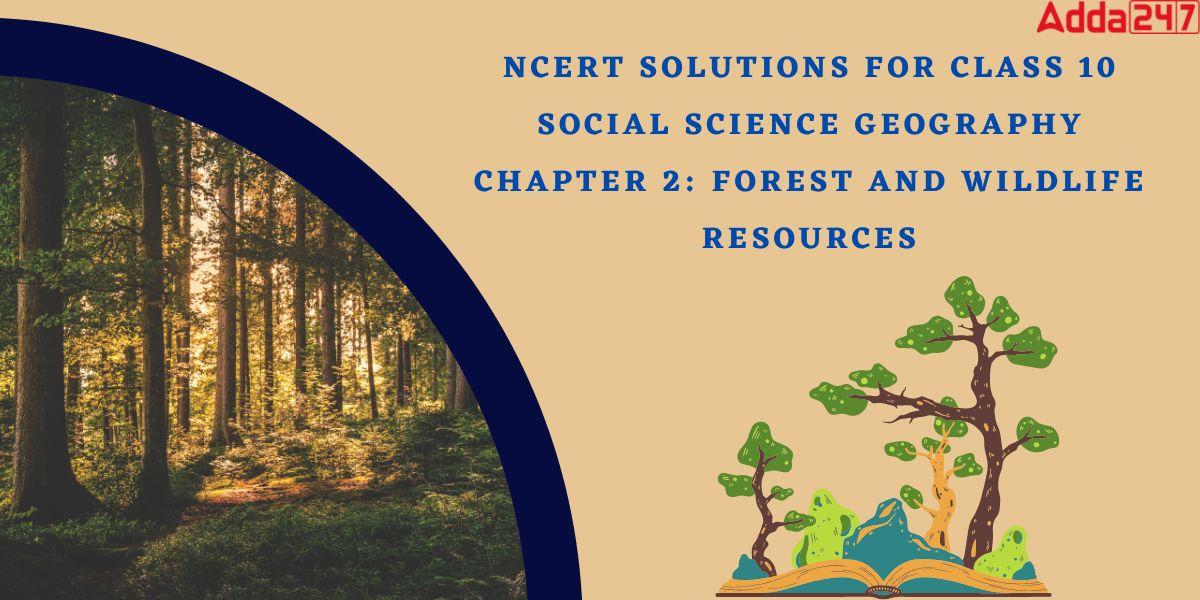NCERT Solutions for Class 10 Geography Chapter 2 Forest and Wildlife Resources Notes
NCERT Solutions for Class 10 Geography Chapter 2 Forest and Wildlife Resources is given in the article.NCERT Solutions Class 10 is the best resource for obtaining a good score in the class 10 board Examination. Your preparation for the CBSE examinations will be aided by the NCERT Solutions for Class 10 Geography Chapter 2 Forest and Wildlife Resources. Here are Adda247 Expert faculty team prepared NCERT Solutions for Class 10 Social Science Geography Chapter 2 Forest and Wildlife Resources along with in-text questions and exercises of that chapter for a better grasp of the topics. These solutions will help you understand the concepts covered in the chapter completely. So that students can pass their board exams with good scores. Keep learning with Adda247.
Read: NCERT Solutions for Class 10 Social Science Geography Chapter 3 Water Resources
>NCERT Solutions for Class 10 Geography Chapter 2 Forest and Wildlife Resources: Quick Revision
NCERT Solutions for Class 10 Geography Chapter 2 Forest and Wildlife Resources Pdf
Click here to download NCERT Solutions For Class 10 Geography Chapter 2 Forest and Wildlife Resources
NCERT Solutions for Class 10 Geography Chapter 2 Forest and Wildlife Resources Question & Answer
1 . Multiple choice questions.
(i) Which of these statements is not a valid reason for the depletion of flora and fauna?
(a) Agricultural expansion.
(b) Large-scale developmental projects.
(c) Grazing and fuel wood collection.
(d) Rapid industrialisation and urbanisation.
Ans:(c) Grazing and fuel wood collection.
(ii) Which of the following conservation strategies do not directly involve community participation?
(a) Joint forest management (b) Beej Bachao Andolan (c) Chipko Movement (d) Demarcation of Wildlife sanctuaries
Ans: (d) Demarcation of Wildlife sanctuaries
2 . Match the following animals with their category of existence.
| Animals/Plants | Category of existence |
| Black Buck | Extinct |
| Asiatic Elephant | Rare |
| Andaman wild pig | Endangered |
| Himalayan Brown Bear | Vulnerable |
| Pink Head Duck | Endemic |
Ans:
| Animals/Plants | Category of existence |
| Black Buck | Endangered |
| Asiatic Elephant | Vulnerable |
| Andaman wild pig | Endemic |
| Himalayan Brown Bear | Rare |
| Pink Head Duck | Extinct |
3 . Match the following.
| Reserved Forests | Other forests and wastelands belonging to both government and private individuals and communities |
| Protected Forests | Forests are regarded as most valuable as far as the conservation of forest and wildlife resources |
| Unclassed Forests | Forest lands are protected from any further depletion |
Answer:
| Reserved Forests | Forests are regarded as most valuable as far as the conservation of forest and wildlife resources |
| Protected Forests | Forest lands are protected from any further depletion |
| Unclassed Forests | Other forests and wastelands belonging to both Government and private individuals and communities |
4 . Answer the following questions in about 30 words.
(i) What is biodiversity? Why is biodiversity important for human lives?
- The use of plants in medicine is crucial. For instance, 25% of pharmaceuticals used in modern medicine are derived from plants found in rainforests, and 70% of cancer medications are either natural or artificial substances that were inspired by nature. This implies that we lose out on a potential new treatment every time a species goes extinct.
- Decreased rates of diseases like Lyme disease and malaria have been associated with biodiversity because of protected natural areas. 60% of infectious diseases come from animals, and 70% of newly emerging infectious diseases come from wildlife, even if the actual source of the virus that causes COVID-19 is still unknown. We decrease the size and number of ecosystems as a result of human activities encroaching on the natural world through deforestation and urbanization. Animals now coexist more closely with people and other animals, which is conducive to the spread of zoonotic illnesses.
- Biodiversity safeguards us
- The earth’s biodiversity makes it habitable. Biodiverse ecosystems offer environmentally friendly remedies that protect us from calamities like floods and storms, filter our water, and replenish our soil.
- The loss of more than 35% of the world’s mangroves to human activity has increased the risk of flooding and sea level rise for both people and their dwellings. A loss of today’s mangroves would result in an annual rise in flooding of 18 million people (an increase of 39%) and an increase in property damage of 16% ($82 billion).
- In order to combat climate change, natural habitats must be preserved and restored. 37% of the cost-effective CO2 mitigation required by 2030 to keep global warming under 2°C might be met by natural alternatives.
(ii) How have human activities affected the depletion of flora and fauna? Explain.
5 . Answer the following questions in about 120 words.
(i) Describe how communities have conserved and protected forests and wildlife in India?
- When the Maldharis, or the Gir shepherd community, take their sheep out for grazing in Gujarat, they frequently come face to face with the renowned wild Asiatic lions. They occasionally also suffer financial loss since some of their animals are killed by lion attacks. They continue to coexist with these predators, even taking joy in their presence as such magnificent natural neighbors.
- Even now, tigers and people coexist as predators and prey in West Bengal’s Sundarbans mangroves. When villagers approach the tiger area to gather crabs or fish, they frequently come into contact with tigers and occasionally become victims of tiger attacks. These villagers nevertheless hold the tiger in high regard despite such losses. For them, the tiger guards the forest, which provides them with their livelihood. Every time they enter the forest, they pray to the Bonbibi, or forest Goddess, to protect them from tigers. If tragedy still befalls them, they typically accept it as fate rather than holding the tiger responsible for their loss.
- The Adivasi community of Mumbai’s Aarey Forest has been added to the list. They share their space with a group of 10 to 14 leopards. For them, the leopard represents God, whom they revere as the “Waghobha.” Even shrines have been built for their leopard God. They crack a coconut shell and offer a prayer to the Waghoba when they hear a leopard roar, pleading with him to spare their animals and protect the forest, which is a source of life for everyone.
(ii) Write a note on good practices for conserving forests and wildlife.
- programmable deforestation ——
- Protection against forest fires—-—
- Reforesting
- Improved Farming Methods
- To conduct a survey and gather all available data on wildlife, particularly about their growth and population.
- To protect woods in order to protect habitat.
- To define the boundaries of their native environment (iii).
- To save animals from natural disasters and pollution.
- Completely banning all forms of wildlife hunting and capture.
- Implementing limitations on the import and export of wildlife goods and enforcing harsh penalties against offenders.
- To create game sanctuaries for particular wild species or for wildlife in general.
- To put special measures in place to safeguard those species whose numbers are extremely small.
- To increase public understanding of wildlife protection on a national and worldwide level.
- Trained personnel adopt a system for managing animals.
India is a good example of a country where various measures have been implemented to conserve wildlife. More than 500 different species of wild animals, 2,100 different bird species, and over 20,000 different types of reptiles and fish have all been discovered in this diversely wildlife-rich nation.
Approximately 200 species of wild animals and birds have gone extinct in India, and another 2,500 are in danger of doing so, according to estimates. Blackbuck, chinkara, wolf, swamp deer, nilgai, Indian gazelle, antelope, tiger, rhinoceros, gir lion, crocodile, flamingo, and other species are a few of them.
NCERT Solutions for Class 10 Geography Chapter 2 Forest and Wildlife Resources: Video Solution
Found this article helpful?
Reach us by means of a visit or call our senior instructor at +91-9625869989 to figure out additional information about the various choices and streams that are open.
We would really see the value in it on the off chance that you could grant a portion of your insight. By utilizing our application, tests, and YouTube class help, you can unwind any vulnerability, assuming you’re centered around getting the best grades Adda247.
NCERT Solutions for Class 10 Geography Chapter 2 Forest and Wildlife Resources-FAQs
Q.How can I access the online PDF of the NCERT Solutions for Class 10 Geography Chapter 1?
Ans. you can download the detailed NCERT Solutions for Class 10 Geography Chapter 2 PDF from the link given in the article,
Q.How does use Adda247’s NCERT Solutions for Class 10 Geography Chapter 2 Forest and Wildlife Resources benefit you?
Ans. The advantages of using Adda247’s NCERT Solutions for Class 10 Social Science Geography Chapter 2 Forest and Wildlife Resources are as follows:
- A video explanation is provided to students in addition to the NCERT solution.
- Additionally, a PDF is included, which can be downloaded and saved for later use.
Q. Are the solutions for other subjects also available?
Ans. Yes, NCERT solutions for all the subjects are available on Adda247.









 TN 11th Supplementary Result 2025, Tamil...
TN 11th Supplementary Result 2025, Tamil...
 CBSE Class 10 Sample Paper 2025-2026 OUT...
CBSE Class 10 Sample Paper 2025-2026 OUT...
 CBSE Class 12 Sample Paper 2025-26 with ...
CBSE Class 12 Sample Paper 2025-26 with ...










